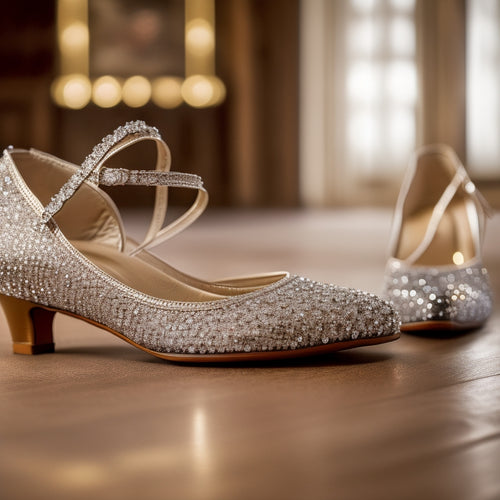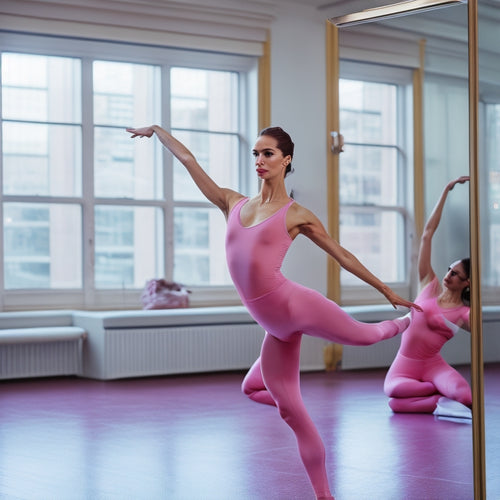
Protect Your Feet: Injury Prevention for Dancers
Share
As a dancer, you're constantly putting your feet through rigorous movements, increasing the risk of injury and soreness. To protect your feet, start by dedicating 15-30 minutes to a thorough warm-up and stretching routine. Prioritize foot care by moisturizing daily, maintaining clean and trimmed toenails, and avoiding shared footwear. Guarantee a safe dance floor by cleaning it regularly and removing obstacles. Learn how to recognize overexertion signs and pace yourself to avoid burnout. By taking these proactive steps, you'll be better equipped to prevent common foot injuries and maintain peak performance - and there's more to explore on this vital topic.
Key Takeaways
• Prioritize daily foot moisturizing to prevent dryness and cracks, ensuring optimal performance and injury prevention.
• Maintain clean and trimmed toenails, and avoid sharing footwear to prevent fungal infections and foot problems.
• Incorporate ankle and foot strengthening exercises, such as Ankle Alphabet and Toe Raises, to increase stability and reduce injury risk.
• Ensure proper footwear with support and traction, and regularly clean the dance floor to remove debris and prevent tripping hazards.
• Recognize warning signs of overexertion and prioritize pace management to avoid burnout, setting realistic goals and taking regular breaks for recovery.
Warm-Up and Stretching Essentials
Before you take the stage, dedicate 15-30 minutes to a thorough warm-up and stretching routine, an essential investment in preventing injuries and optimizing your dance performance. A well-structured warm-up prepares your muscles for the physical demands of dancing, reducing the risk of strains and pulls. It's vital to incorporate flexibility tests to identify areas of limited range of motion, allowing you to focus on improving your overall flexibility.
In addition to flexibility, muscle activation is key. Engage your core, glutes, and legs through exercises like leg swings, lunges, and calf raises. This helps improve your posture, balance, and overall stability. By activating your muscles, you'll reduce your risk of injury and enhance your overall performance.
Remember, a warm-up isn't a one-size-fits-all approach. Tailor your routine to your specific needs and goals, and don't skip it – your body will thank you.
Foot Care for Dancers 101
As you prepare to take the stage, your feet are about to bear the brunt of your performance, making it essential to prioritize foot care to prevent common issues like bunions, plantar fasciitis, and ankle sprains. Neglecting your foot health can lead to chronic pain, discomfort, and even long-term damage.
To avoid this, establish a daily moisturizing routine to keep your skin hydrated and supple. Use a rich moisturizer on your heels, toes, and any areas prone to dryness. This will help prevent cracks and fissures that can lead to infection.
Proper toenail maintenance is also vital. Keep your toenails clean and trimmed, taking care not to cut them too short. This will help prevent ingrown toenails, which can be painful and debilitating.
Additionally, avoid sharing footwear or socks, as this can spread fungal infections like athlete's foot. By prioritizing foot care, you'll be able to perform at your best, without the distraction of discomfort or pain.
Safe Dance Floor Practices
By mastering safe dance floor practices, you'll minimize the risk of collisions, tripping hazards, and other accidents that can derail your performance. A clean and well-maintained dance floor is essential for preventing injuries.
Make sure to:
-
Regularly clean the dance floor: Sweep or vacuum the floor daily to remove debris, dust, and dirt that can cause slipping or tripping.
-
Use the right dance shoes: Wear shoes that are specifically designed for your dance style, providing the necessary support and traction to prevent slipping or falling.
-
Clear the floor of obstacles: Remove any objects, such as bags, water bottles, or props, that could obstruct your movement or cause tripping.
Avoiding Overexertion and Fatigue
Listening to your body and recognizing the warning signs of overexertion is crucial, as pushing yourself too hard can lead to fatigue, injury, and decreased performance. Prioritizing pace management is key to avoiding burnout.
Start by setting realistic goals and breaking them down into manageable chunks. This will help you maintain a sustainable pace and reduce the risk of exhaustion.
Incorporate rest strategies into your routine to allow your body to recover. Taking regular breaks to stretch, hydrate, and refuel is imperative. A well-timed rest can help you recharge and come back stronger.
Don't hesitate to take a step back and reassess your approach if you're feeling overwhelmed. Remember, it's better to pace yourself and make gradual progress than to risk injury and setback.
Strengthening Ankles and Feet
Weak ankles and feet can be a dancer's downfall, leaving them prone to injuries like sprains, strains, and fractures. Targeted exercises are essential for building strength and stability in these critical areas, greatly reducing the risk of injury. Incorporating ankle and foot strengthening exercises into your routine is key.
Here are three exercises to get you started:
-
Ankle Alphabet: Write the alphabet with your toes, starting from A and moving up to Z. This exercise improves ankle mobility and strength.
-
Toe Raises: Stand on the edge of a stair or step with your heels hanging off the edge. Slowly raise up onto your tiptoes and then lower back down. This exercise targets the muscles in your feet and ankles.
-
Single-Leg Balance: Stand on one leg, keeping the other foot lifted off the ground. Hold for 30 seconds and then switch legs. This exercise improves balance and stability.
In addition to exercises, consider incorporating foot orthotics or shoe inserts into your routine. These can help redistribute pressure and alleviate stress on your ankles and feet.
Frequently Asked Questions
Can I Still Dance With a Pre-Existing Foot Condition?
If you have a pre-existing foot condition, you can still dance, but it's essential you take precautions. You'll need to contemplate footwear modifications and make performance adjustments to accommodate your condition, ensuring a safe and successful dance experience.
How Do I Prevent Toenail Fungus and Infections?
"Imagine your toes as a fungus-friendly resort - not! You prevent toenail fungus and infections by practicing good hygiene, washing your feet daily, and drying them thoroughly, especially between the toes, as part of your foot care routine."
Are There Specific Shoe Types for Different Dance Styles?
When choosing shoes, you'll find that different dance styles require specific types: for ballet, opt for Pointe Perfect shoes with a snug fit, while for high-energy Jazz Jives, select shoes with extra support and cushioning to reduce shock.
Can I Use Orthotics or Arch Supports in Dance Shoes?
You can definitely use orthotics or arch supports in dance shoes, especially if you have foot issues; consider custom insoles for a precise fit, and be prepared to make dance modifications to accommodate your new supportive footwear.
What Are the Best Treatments for Plantar Fasciitis in Dancers?
When treating plantar fasciitis, you'll find that a combination of physical therapy exercises and night splints can be highly effective in reducing pain and inflammation, allowing you to get back to dancing quickly and safely.
Related Posts
-

3 Essential Tools for Dance Makeup Artists Online
As a dance makeup artist, you already possess the skills to create stunning looks, and with the right digital tools, ...
-

Best Ballroom Dance Shoes for International Style
When you're selecting the best ballroom dance shoes for International Style, focus on essential features like grip, c...
-

Dance Practice Wear Picks for Maximum Comfort and Performance
When choosing dance practice wear, you want gear that optimizes comfort and performance. Opt for moisture-wicking fab...


